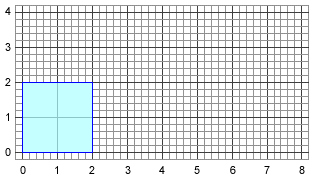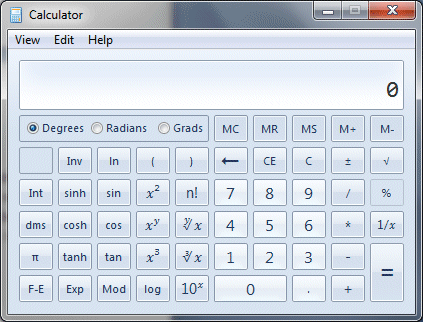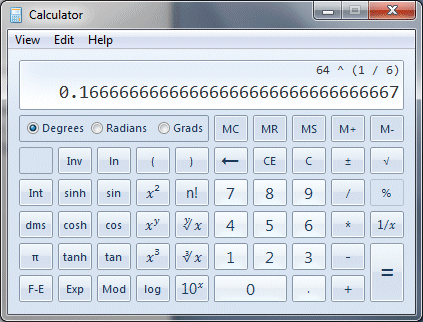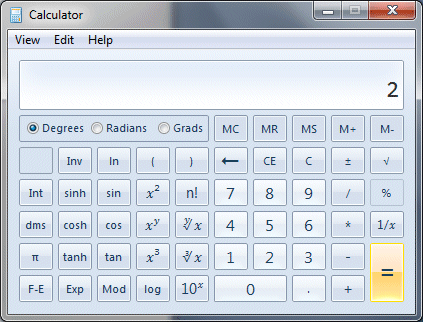| Author: | |
| Website: | |
| Page title: | |
| URL: | |
| Published: | |
| Last revised: | |
| Accessed: |
Powers and roots are used extensively in mathematics, so it is important to get a good grasp of what they are and how (and why) they are used. Two other closely related terms we will be looking at are indices and exponents. In some ways powers and roots are two ways of looking at the same thing. It will become clear later how the two are related. We will first examine what powers are. Consider the following expression:
2 × 2 × 2 × 2 × 2 = 32
This expression multiplies five instances of the number two together to get the result thirty-two. Straightforward enough, you will agree. However, there are many occasions when we will want to multiply a number by itself multiple times. Writing such an expression out in this form will become somewhat tedious. Fortunately, there is a much shorter form we can use for this kind of expression. Here is the short form for the above example:
2 5 = 32
The term to the left of the equals sign (2 5) represents two to the power of five, which is another way of saying 2 x 2 × 2 × 2 × 2. The number to be multiplied (in this case two) is referred to as the base. The superscripted number to the right of the base (in this case five) tells us how many instances of the base will be multiplied together, and is called the index or exponent (these two words basically mean the same thing in this context). Here are a few more examples of this notation:
3 2 = 3 × 3 = 9
4 3 = 4 × 4 × 4 = 64
5 4 = 5 × 5 × 5 × 5 = 625
2 10 = 2 × 2 × 2 × 2 × 2 × 2 × 2 × 2 × 2 × 2 = 1024
The last example here should be familiar to computing students as it represents the number of bytes in a kilobyte. In fact powers of two, with indices consisting of successive multiples of ten, are significant in computing because they represent successive orders of magnitude in terms of computer memory:
2 10 bytes = 1 Kilobyte (1,024 bytes)
2 20 bytes = 1 Megabyte (1,048,576 bytes)
2 30 bytes = 1 Gigabyte (1,073,741,824 bytes)
2 40 bytes = 1 Terabyte (1,099,511,627,776 bytes)
It should be fairly self-evident that using indices (or if you prefer, exponents) to represent how many instances of a number we want to multiply together is a very convenient and time saving mathematical notation. The down side is that the meaning of a term such as 3 2 (three to the power of two) is not quite as obvious at first glance as if we write 3 × 3 (three multiplied by three). Like most things in life however, once you become familiar with it this notation can make things very much easier in the longer term. When a number is raised to the power of two (i.e. multiplied by itself), we refer to it as being squared. This is because we can represent a number that is raised to the power of two (i.e. squared) by drawing a square of the appropriate dimensions on a piece of graph paper. The illustration below shows a graphical representation of the number two raised to the power of two (2 2). If you count the squares inside the rectangle, there are four (i.e. two multiplied by two).

A graphical representation of two squared
If we raise a number to the power of three, it is said to be cubed. Two to the power of three (i.e. 2 3 or 2 × 2 × 2) can be visualised as a three dimensional shape (a cube) like the one illustrated below. Each side of the cube spans two individual blocks. If you count the total number of blocks that make up this cube (which I think must have belonged to Rubik's younger brother), you will find that there are eight (2 × 2 × 2).

Numbers to the power of three are said to be "cubed"
Powers greater than three are not so easy to visualise, and tend not to be referred to by user-friendly terms like "squared" or "cubed". Nevertheless they do occur with some regularity, and we need to be able to deal with them. Arithmetic involving numbers raised to various powers is not really as difficult as you might think, however. We can call on a basic set of rules known as the laws of indices to help us manage the process.
The laws of indices provide us with rules for carrying out operations like multiplication and division involving numbers expressed as powers. One thing to remember however is that they only hold true for powers that have the same base. For example, we can easily simplify an expression such as 3 4 × 3 3, but we cannot simplify an expression such as 3 2 × 5 3 because the bases are different. It is worth mentioning at this point that powers can be applied to algebraic terms (in which an unknown value is represented by a letter of the alphabet) in exactly the same way as they are applied to numbers. The following examples serve to illustrate this:
a 2 = a × a
b 3 = b × b × b
The laws of indices can be applied to algebraic expressions involving powers, but exactly the same restriction applies with regard to the terms having to have the same base. We can, for example, simplify the expression a 2 × a 4 using the laws of indices, because in both cases the base is a. We cannot simplify the expression a 2 × b 3, because the bases are different.
The first index law is also known as the index law for multiplication. It deals with how we can multiply exponentiations together. An exponentiation is what we sometimes call something that has been raised to some power. Now that you know that, we will henceforth simply call them powers. The index law for multiplication states that when we want to multiply powers together, we add the indices. Some examples will serve to illustrate the point.
2 3 × 2 4 = 2 7
a 2 × a 3 = a 5
5 4 × 5 -2 = 5 2
a m × a n = a m+n
The ability to multiply powers together simply by adding the indices is very convenient, since it removes the need to expand each of the terms individually and then multiply them together. Note that in the third example we have a negative index, which denotes a fractional value (5 -2 = 0.04). We will be talking about negative indices in due course. Suffice it to say that the index law for multiplication works perfectly well regardless of the polarity of the indices. The last example is essentially a generalisation of the law expressed in algebraic form.
Being able to multiply powers together by adding their indices is particularly useful for disciplines like engineering and electronics, where quantities are often expressed as a value multiplied by some power of ten. In the field of electrical engineering, for example, the relationship between electrical current, voltage and resistance in an electrical system is critically important, and yet the typical unit values for these properties can differ by several orders of magnitude. Typical resistances in a circuit tend to be measured in thousands or millions of ohms, while currents are typically measured in thousandths or millionths of an ampere. The voltage in a circuit is calculated as the product of current and resistance, so if we have a total circuit resistance of 1 kilohm (1000 ohms) and a measured circuit current of 5 milliamperes (0.005 amperes), we can calculate the voltage drop across the circuit as follows:
1×10 3 Ω × 5×10 -3 mA = 5×10 0 V = 5 V
We can simply multiply one kilohm by five milliamps to get the answer five, ignoring the fact that the units in which the two multiplicands are expresed are completely different. In order to obtain the magnitude of the answer (i.e. by what power of ten must we multiply five to get the actual voltage), we just add the index for the resistance (three) to the index for the current (minus three), which gives us zero. Since any non-zero number to the power of zero is one, the answer is five multiplied by one, which gives us five volts. The alternative is a calculation that looks like the one below. This calculation would give us the correct answer, providing we managed to get the decimal point in the right place. From personal experience, that is something that students of electronics often have a problem with, even when using a calculator!
1000 Ω × 0.005 mA = 5 V
One further point before we move on. I can hear you asking how we know, with reference to the above example, that a kilohm is 10 3 ohms and a milliamp is 10 -3 amps. The short answer is that if you study, or work in, a field such as electrical engineering you very quickly familiarise yourself with the standard units of measurement. Furthermore, the powers of ten in which the standard units are expressed are invariably multiples of three (or minus three). Here are some examples of standard unit prefixes:
giga - 10 9 (× 1,000,000,000)
mega - 10 6 (× 1,000,000)
kilo - 10 3 (× 1,000)
milli - 10 -3(× 0.001)
micro - 10 -6 (× 0.000001)
nano - 10 -9 (× 0.000000001)
pico - 10 -12 (× 0.000000000001)
The second index law is also known as the index law for division. It deals with how we can divide one power by another. The index law for division states that when we want to divide one power by another, we subtract the divisor index from the dividend index. Some examples will serve to illustrate the point.
2 4 ÷ 2 2 = 2 2
a 5 ÷ a 4 = a 1
5 4 ÷ 5 -2 ÷ 5 3 = 5 3
a m ÷ a n = a m-n
As with the multiplication of powers, dividing one power by another simply by subtracting one index from another is very convenient, and removes the need to expand each of the terms individually and then carry out the division. The last example can again be used as a generalisation of the law expressed in algebraic form.
The third index law is known as the power of zero (or zero power rule). It should have become evident to you that since the index of a power represents the number of instances of a base that are multiplied together, then something to the power of one simply equals itself. Hence, two to the power of one (2 1) equals two, five to the power of one (5 1) equals five, and so on. But what if we raise something to the power of zero? Think about the second index law for a moment, and consider an expression such as:
2 3 ÷ 2 3 = 2 0 = 1
Whenever we divide a power by itself, the indices of the dividend and the divisor will obviously be the same. Subtracting the index of the divisor from the index of the dividend will therefore result in an index of zero. Since we know that dividing something other than zero by itself always equals one, the logical conclusion is that when any non-zero base is raised to the power of zero, the result is always one. This is the third index law, and we can express it algebraically as:
a 0 = 1
If the base is zero (i.e. 0 0), then the result is also zero. In fact, zero raised to any non-negative power produces a result of zero (raising zero to a negative power implies division by zero, and the result is therefore considered to be undefined).
The fourth index law, also known as the index law for powers, deals with the case where one power is raised to another power. Consider for example the following expressions:
(2 3) 2 = 2 6 = 64
(5 2) 2 = 5 4 = 625
(6 2) -1 = 6 -2 = 0.028
By analysing the first example we can see that the power inside the brackets (2 3) is being raised to the power of two, i.e. it is being multiplied by itself. We could therefore re-write the expression as 2 3 × 2 3. We know from the first index law that when multiplying powers together we simply add the indices, which in this case gives us two to the power of six (2 6). When we raise a power (a m) to another power (n), we are multiplying together n instances of a m. The result will therefore be a raised to the power of m × n. The fourth index law can be expressed algebraically as:
(a m) n = a m × n
The fifth index law is also known as the index law for powers of products. Consider the following expression:
(3 × 5) 2 = 3 2 × 5 2 = 9 × 25 = 225
The fifth index law states that when a product is raised to a power, every factor of the product is raised to that power. This can be stated algebraically as:
(a × b) n = a n × b n
The sixth index law is called the index law for powers of quotients and deals with the case where the base is a rational number (i.e. a fraction).
| ( 3/4) 3 = | 3 | × | 3 | × | 3 | = | 3 × 3 × 3 | = | 9 | = 0.140625 |
| 4 | 4 | 4 | 4 × 4 × 4 | 64 |
When we have an expression in which we multiply fractions together, the result will be a fraction in which the numerator is the product of the numerators of the terms, and the denominator is the product of their denominators, as shown above. When we raise a fraction to the nth power ,we are multiplying together n instances of that fraction. That means we are multiplying together n instances of the numerator and n instances of the denominator to get the new numerator and denominator respectively. We can therefore rewrite (and simplify) the above expression as follows:
| ( 3/4) 3 = | 3 3 | = | 9 | = 0.140625 |
| 4 3 | 64 |
The sixth index law can be stated algebraically as:
| ( a/b) n = | a n |
| b n |
A power with an index that is a positive integer n indicates that we want to multiply together n instances of the base. When the index is a negative integer, the indication is that we want to find the reciprocal of the base raised to the power n (i.e. one divided by the base to the power n). Consider the following expression:
| 2 3 ÷ 2 4 = | 2 × 2 × 2 | = | 8 | = | 1 | = 0.5 |
| 2 × 2 × 2 × 2 | 16 | 2 |
We could write this expression in another way, using the second index law (the index law for division) and applying what we know about negative indices:
| 2 3 ÷ 2 4 = 2 -1 | = | 1 | = | 1 | = 0.5 |
| 2 1 | 2 |
By definition, two to the power one is two. We show it in the above expression to make the point that any (non-zero) base to the power -n is the reciprocal of the same base to the power n. We can use another example to further illustrate the principle.
| 3 2 ÷ 3 5 = | 3 × 3 | = | 9 | = | 1 | = 0.037037 |
| 3 × 3 × 3 × 3 × 3 | 243 | 27 |
Re-writing the expression as we did before gives us:
| 3 2 ÷ 3 5 = 3 -3 | = | 1 | = | 1 | = 0.037037 |
| 3 3 | 27 |
For any non-zero base a, and any positive integer n, we can formalise this algebraically as:
| a -n | = | 1 |
| a n |
Re-arranging this expression gives us:
| 1 | = a n |
| a -n |
We have so far talked about powers that have integer exponents (either positive or negative). We have so far avoided any mention of exponents that are rational numbers (i.e. fractions) although you may well have come across these at some point. The reason for this apparent procrastination is that the subject of rational exponents cannot be dealt with without also talking about roots. The nth root of a number a is a number b which, when n instances of it are multiplied together, produces a. In other words, b to the power n equals a, and b is said to be the nth root of a. We can express this in algebraic form as:
n√a = b
The symbol "√" seen here is called a radical, and terms in which the radical appears are often called radicals (or sometimes surds). The most common type of numerical root we encounter is the square root. The square root of a number a is the number which when raised to the power two (i.e. multiplied by itself, or squared) produces a. For example, since two multiplied by two (2 × 2 or 2 2) equals four, the square root of four is two ( 2√4 = 2). Actually, we should say that one of the square roots of four is two, since minus two squared also equals four (-2 2 = 4). In fact, any positive real number has two square roots. Both have the same absolute value, but one is positive and the other is negative. The positive square root of a number is sometimes refereed to as its principal square root. We can express the square root of a number a in index form (i.e. as a power) as follows:
2√a = a 1/2
Another type of root you have probably encountered is the cube root. The cube root of a number a is the number b which when raised to the power three (i.e. three instances of b multiplied together, or b cubed) produces a. For example, the product of three instances of four multiplied together (4 × 4 × 4 or 4 3) equals sixty-four, so the cube root of sixty-four is four ( 3√64 = 4). Sixty-four has only one (positive) cube root, since any negative number raised to the power of three would produce a negative result. This highlights a feature of roots, which is that only negative numbers can have negative odd numbered roots. You might also have deduced from what we have said so far that negative numbers cannot have square roots (at least not square roots that are real numbers). This can be a problem for some types of calculations used in areas such as engineering and electronics, so the concept of imaginary numbers is used to get around this problem (the topic of imaginary numbers will be dealt with elsewhere). We can express the nth root of a number a in index form (i.e. as a power) as follows:
n√a = a 1/n
Although the fourth, fifth and higher roots are not so frequently encountered, they nevertheless crop up from time to time and we need to be able to deal with them. Expressing roots as powers not only gives us a convenient notation for the higher roots, it enables us to use a calculator to evaluate them when required to do so. The screenshot below shows the scientific version of the Microsoft Windows built-in calculator. You can find this by clicking on the start button in Windows 7 and selecting All Programs>Accessories>Calculator (other versions of Windows might require a different sequence of keystrokes). The scientific version of the calculator can be selected from the application's View menu.

The Microsoft Windows built in calculator
Microsoft have actually made life easy, because they have provided buttons both for calculating x to the yth power and for finding the yth root of x. Not all calculators have the yth root facility, but most have a button for calculating x to the power y. Let's see how we can find the sixth root of sixty-four ( 6√64) on the average scientific calculator. Using the Windows calculator if you have it, or any suitable scientific calculator if you don't, enter the following keystrokes:

Enter these keystrokes on the calculator
Here is the complete entry up to (but not including) the equals keystroke:

Finding the 6th root of 64
Note that the number displayed on the answer line is the intermediate result of evaluating the expression within the brackets (i.e. one divided by six). Here is the final screen that will be displayed once the equals key has been pressed:

The 6th root of 64 is 2
We evaluated the expression sixty-four to the power one over six (64 1/6) to find the sixth root of sixty-four, which gave us a result of two. Two is indeed the sixth root of sixty-four ( 6√64 = 2). We can generalise the relationship between roots and powers algebraically as follows:
a m/n = (a m) 1/n = n√a m
The value of m must always be an integer, and the value of n must always be a positive integer (note that in the examples we have looked at so far, the value of m has been one). From the foregoing, it will be clear to you that whenever you see a power that has a rational number as its index, you are dealing with a term that can be expressed as a root. Conversely, it also means that we can eliminate terms that are explicitly written as roots (i.e. that use the radical symbol) by expressing them instead as powers. This can be seen as part of a simplification process. In mathematics an expression that contains radicals is not generally considered to be in its simplest form, although for some purposes such an expression is perfectly acceptable. Fractional indices tend to appear somewhat intimidating, especially when the numerator is greater than one. The trick is to know how such terms can be manipulated by being familiar with the generalised algebraic relationships. The following example illustrates how we can evaluate such an expression:
8 2/3 = (8 2) 1/3 = 64 1/3 = 3√64 = 4
Of course, not all of the expressions we encounter will work out quite as neatly. Having reduced a rational power to the nth root of a number, a decision is often required as to whether or not to convert the answer to a decimal value (which is easy enough to do on a modern scientific calculator). This normally depends on the degree of precision we can achieve, and on what stage we are at in our calculations. If there are more terms to be evaluated (i.e. the answer we have arrived at is an intermediate one), it may be better to leave the answer in its radical form for now. We will leave you with a couple of pointers with regard to manipulating roots. First, for any two non-negative real numbers a and b:
n√a × n√b = n√ab
For example:
3√27 × 3√64 = 3√1728 = 12
Secondly, for roots involving fractions:
n√ a/b = n√a ÷ n√b
For example:
2√ 36/25 = 2√36 ÷ 2√25 = 6 ÷ 5 = 1.2